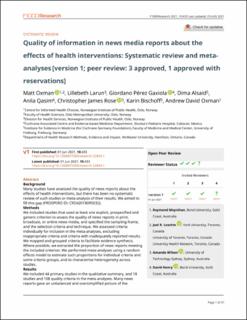| dc.description.abstract | Background: Many studies have assessed the quality of news reports about the effects of health interventions, but there has been no systematic review of such studies or meta-analysis of their results. We aimed to fill this gap (PROSPERO ID: CRD42018095032). Methods: We included studies that used at least one explicit, prespecified and generic criterion to assess the quality of news reports in print, broadcast, or online news media, and specified the sampling frame, and the selection criteria and technique. We assessed criteria individually for inclusion in the meta-analyses, excluding inappropriate criteria and criteria with inadequately reported results. We mapped and grouped criteria to facilitate evidence synthesis. Where possible, we extracted the proportion of news reports meeting the included criterion. We performed meta-analyses using a random effects model to estimate such proportions for individual criteria and some criteria groups, and to characterise heterogeneity across studies. Results: We included 44 primary studies in the qualitative summary, and 18 studies and 108 quality criteria in the meta-analyses. Many news reports gave an unbalanced and oversimplified picture of the potential consequences of interventions. A limited number mention or adequately address conflicts of interest (22%; 95% CI 7%-49%) (low certainty), alternative interventions (36%; 95% CI 26%-47%) (moderate certainty), potential harms (40%; 95% CI 23%-61%) (low certainty), or costs (18%; 95% CI 12%-28%) (moderate certainty), or quantify effects (53%; 95% CI 36%-69%) (low certainty) or report absolute effects (17%; 95% CI 4%-49%) (low certainty). Discussion: There is room for improving health news, but it is logically more important to improve the public’s ability to critically appraise health information and make judgements for themselves. | en_US |

